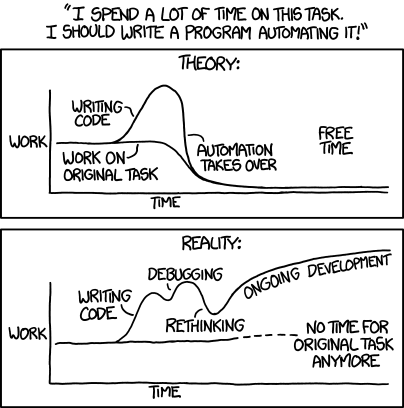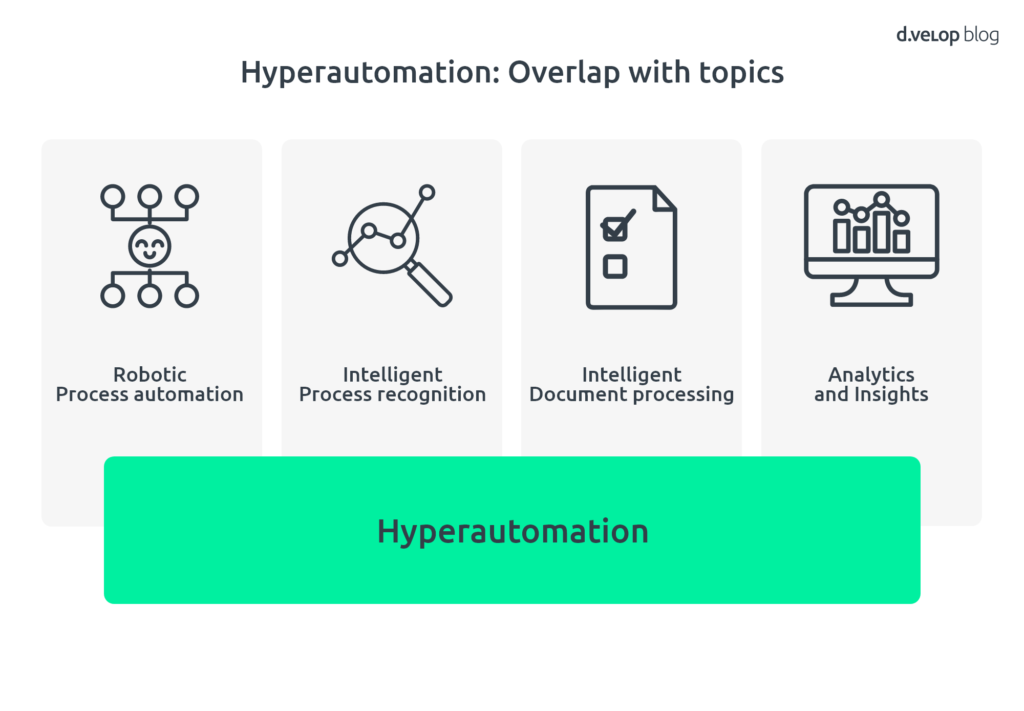The topic of hyperautomation was already identified by Gartner as one of the 10 most important strategic technology trends in 2022. According to Gartner, hyperautomation will help companies reduce their operational costs by 30 percent by 2024.1 But what exactly does hyperautomation mean and does the topic actually offer potential for companies?
What is hyper automation?
In companies, recurring processes are identified that can benefit from automation. With the help of software, robots or other possible techniques, gains such as: efficiency increases, costs reductions and the quality of employee engagement can be enhanced.
However, hyperautomation goes one step further. It tries to connect all available technologies in the company in order to ultimately automate more and more complex business processes. Simplicity, speed, intelligence and connections are paramount.
The following definition makes the scope of hyperautomation very clear:
Definition Hyperautomation
Hyperautomation is a strategic approach in companies to identify, review and automate as many business and IT processes as possible. Hyperautomation is not a new technology per se, but an orchestrated use of multiple existing technologies, tools, or platforms. These include: artificial intelligence (AI), machine learning, event-driven software architecture, robotic process automation (RPA), business process management ( BPM ) and intelligent business process management (iBPMS) suites, integration platforms as a service (iPaaS), low-code/no-code tools , software packages and other types of decision, process and task automation tools.2
3 reasons for hyperautomation
1. Efficiency gain & reduction of operating costs
By automating as many processes as possible, organisations can reap a number of substantial benefits. Increased productivity to support growing demand, support IT teams to tackle the delay in projects, whilst ensuring better regulatory compliance. As automation grows, it provides a higher level of consistency and minimises the possibility of human error. As companies and specialist departments are able to eliminate unnecessary steps in a task and at the same time, automate the remaining ones, hyperautomation enables greater project momentum. As Gartner predicts, the result is streamlined business processes that reduce the need for unnecessary human intervention, increase efficiency and reduce costs.
An example of the gain in efficiency through hyperautomation in private life
During the basic renovation of our house, we made sure to design the house as intelligently as possible. For example, the light adjusts according to presence and lighting conditions, the venetian blind systems adjust themselves to the sun and temperature, the towel radiator recognises the shower process and the mailbox reports the insertion of a letter. All these little things help to make everyday life easier, more efficient and assists in sustainability.
2. Stock in competition
In the words of Fabrizio Biscotti, research vice president at Gartner, “Hyperautomation has evolved from an option to a condition for survival. Organisations will require more IT and business process automation as they are forced to accelerate their digital transformation plans in a post-COVID-19 and digital-first world.” 1
In order to survive in competition, especially in an international comparison, companies have to deal with the possibilities of process automation and take holistic approaches and state-of-the-art technologies into account.
3. Meaningful tasks for employees
Hyperautomation is based on the idea of giving employees more meaningful activities. Tasks with a higher degree of added value should be assigned to people who, in principle, carry out banal activities for which a machine or software could just as well be used. However, why aren’t such monotonous tasks already automated when employees probably feel this pain on a daily basis?
That is why business processes in many companies are often not very automated
The pain of lack of automation is often felt only by those closest to the business process. It is precisely these that often have to go a long way in order to automate them. At the beginning, the employee has to contact the IT department and hope that their process can already be automated. As the IT department is overwhelmed with requests, it takes time to process the request. After a long wait, the IT department approaches the employee with a solution. Of course, the employee immediately discovers further automation potential when using it or minor adjustments are required, so back to the IT department’s queue. It often takes weeks and months to automate a simple, monotonous process.
Not only the specialist departments shy away from this development process, but also the IT department. As shown in the figure below, reality often negates theory!

Theory vs. Reality 3
No-code approaches are an important key on the way to hyperautomation
With the help of no-/less-code platforms, specialist departments are able to map and automate their processes themselves. This reduces the actual development process enormously, results in fewer communication errors and in most cases, specially developed processes are far more productive.
With the d.velop process studio, departments can automate document-based processes themselves
With the new d.velop process studio, you can benefit from a no-code approach. With the process studio, we have created a dynamic visual environment that will enable specialist departments to map their own processes. Of course, no-code requires a balance of input from both IT administrators and specialist departments working together.
The specialist department outlines its process directly in the d.velop process studio, identifying each stage of the process and what information is required at which point. The IT administrator then ensures that the necessary information from third-party systems is used in the appropriate places.
Here is an example of an approval process shown directly in the studio:
With the no-code approach, we enable specialist departments to model their process in the right tool landscape. The IT department implements the communication routes, which can also be developed in such a way, that they can be reused in other specialist processes. This streamlines the development process; the limits of no-code are directly supported by the IT department. The resulting process is fine-tuned, all unnecessary steps removed by modelling. This ultimately providing greater efficiency, offering reduced costs and increasing employee satisfaction.
Intelligent document processing is ever increasing. d.velop automates document-based processes, supporting you on your journey to hyper-automation.

Establishing hyperautomation in the company – how can it succeed?
Entrepreneurs should already provide employees with the appropriate freedom and motivate them to consider optimisation through automation. There are many companies who have initiated schemes that promise their employees a share of the profits from the savings, if they identify potential savings in processes. Whether through such a scheme or in alternative ways: it is important to ensure that as many employees as possible, perceive potential for optimisation.
As soon as an employee notices in everyday work that an activity is not value-adding, meaningful and recurring, he should ask himself whether this activity can be automated with the given tools. The topic of process automation is critical to ongoing business improvement. As identified, it enables cost reduction, increased productivity, enhanced employee satisfaction and in many cases, the added benefit of customer satisfaction and advocacy.
Demo of the d.velop process studio 💻
Book your individual software demo of the d.velop process studio in our document management system with just a few clicks. Let our experts demonstrate the software live and ask your questions directly.
